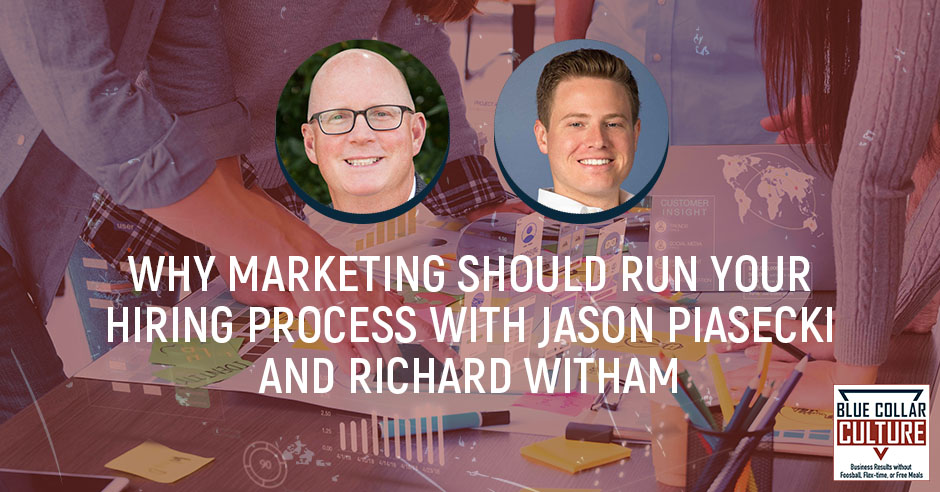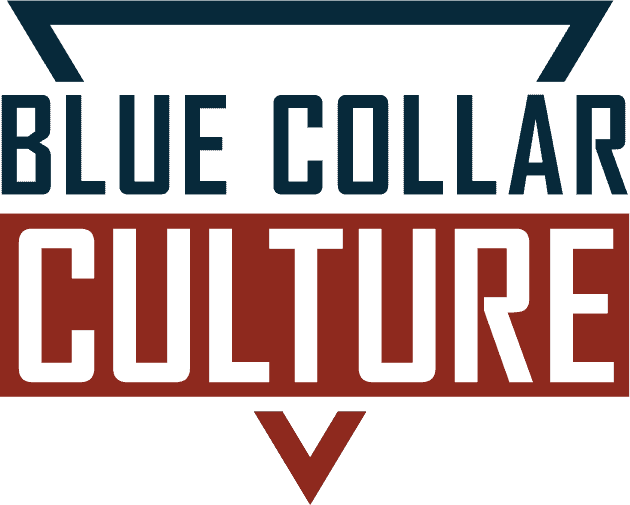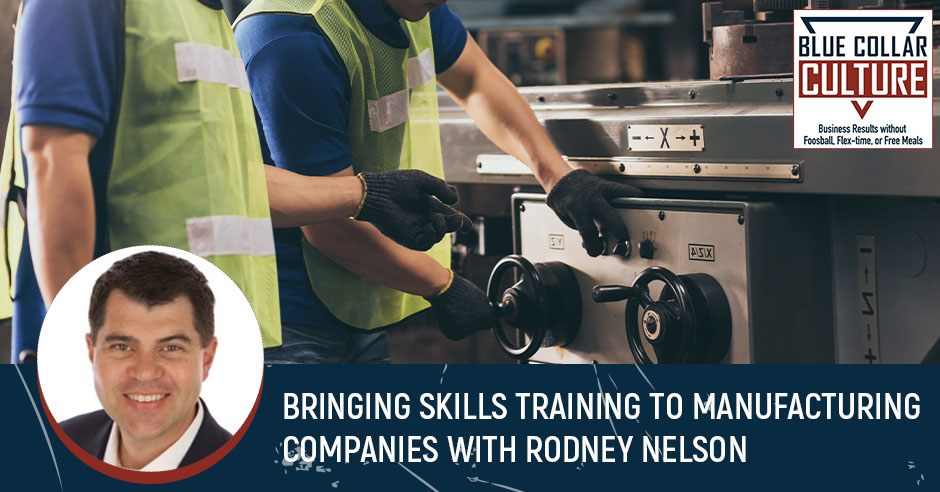
When talking about a company’s hiring process, the HR department comes to mind. If you face some challenges when acquiring and retaining people, perhaps you need to try a refreshing strategy. Featured in this episode is Jason Piasecki, a Partner and the CEO of Revel. He discusses the benefits of letting marketers run your recruitment process. Joining him is Richard Witham of Motion Dynamics Corporation, who shares how Jason and his team helped them set up this unique hiring process. Together, the two talk about the fruits of their partnership and how they stay on top of the rapid workflow.
—
Why Marketing Should Run Your Hiring Process With Jason Piasecki And Richard Witham
It’s no secret that I believe that when it comes to recruiting, it is best left in the hands of your marketing team and not your HR team. We’re excited to talk to our guests. We’ve got two guests in this episode. This is something we’ve never done before. We’re going to be talking to a marketing expert who shares that same belief when it comes to recruiting, and we have one of his clients who has been on the receiving end of the incredible results that they’ve been able to generate.
Our first guest is Jason Piasecki. He is a Partner and the CEO of Revel. They are a marketing company that does some great things when it comes to helping companies better recruit talent. Joining us is Richard Witham. He’s with Motion Dynamics Corporation. He has been on the receiving end of some of the work that Jason and his team have done to help them recruit better people. We’re going to have a great conversation about the idea that marketing can help transform your recruiting results.
—
Jason, Richard, welcome to the show.
We’re happy to be here.
Thanks, Ryan. I’m happy to be here too.
I’m excited about this conversation. As we get started here, tell me what the biggest myth in your mind is when it comes to hiring.
The biggest thing that we see as a marketing agency is that manufacturers and B2B companies don’t need a creative campaign to attract employees and differentiate themselves. A lot of times, we find it’s just business as usual. It’s understanding that there’s a seat at the table for marketing when it comes to their recruitment.
You’re saying the biggest myth is that they think that they don’t need to market. They just need to go get people. Let’s dive into that a little bit more. I love that because we have our book coming out, Hire Better People Faster, and that’s one of its tenets. We often think that hiring needs to be in the HR function, but you’re saying that you’ve had great success in its marketing function.
We typically find that we have the best success with our clients when it’s a collaborative effort, and HR is at the table with leadership, and they’re talking to their employees. There’s an opportunity for a marketing partner to get involved either in an in-house team or an outsource agency.
We get to have both of you for this interview. We get to have the marketing seat and the client’s seat on this. We’ll bounce back and forth as we go through this. Why marketing? Why have that as an important part of this? I’ll let the marketing guy go with this one.
That’s an easy one for me. Everyone has a unique story and employer brand that is theirs alone. Often, people think that they have to attract employees at the expense of other companies out there when the truth is, by telling your story and speaking about why you exist, you can attract the right type of employees and get more qualified candidates through the door. The paradigm has shifted where the power is in the employee’s hands now, so as employers, we need to appeal to them on their own terms and highlight why we’re an attractive choice for them.
By telling your story and speaking about why you exist, you can attract the right type of employees and get more qualified candidates. Click To Tweet
Richard, you’ve brought in Jason. You’ve brought in the marketing seat and made sure that you’ve looked at this from that proactively. Tell us a little bit of your why. Why would employees want to work for you? Then, let’s dig into how that translates into the marketing realm of it.
It’s an easy question to answer. For me and from our perspective, we understand our product. It’s a technical product, and that’s what makes it unique. We’re manufacturing, but most people, even locally, who aren’t familiar with our company don’t understand the uniqueness and importance of the products that we manufacture. They contribute to life-saving efforts. That’s easy for us to understand.
We’re engineers. We’re technical people. We don’t know how to market that, and that’s where Revel comes in. It has been a unique relationship as we’ve grown up together in the same community. We’ve worked together for years. They understand us, and they know how to get that word out differently than we would have thought.
Help me understand this, then. You’re an engineer. You ought to be able to get engineer buddies.
We’re not the most social people.
I wasn’t going to say that. You’re on here. I figured you were at least so. How is marketing going to attract engineers?
It’s presenting our product from a different perspective than we would’ve thought. We’ve always tried to fly under the radar. We were a small company. Our marketing was truthfully at $0 for a long time. We didn’t do social media campaigns, billboards, or anything like that. We were an under-the-radar company. Our target market is R&D engineers.
Over the course of time, mostly through word of mouth, we built a reputation in the industry that positions us where we want to be. This is thinking in a different way than we’ve ever had to attract people to the team. It’s a language that I don’t speak. Jason and the team at Revel understand us better than we understand ourselves in a lot of ways.
If I could add one thing to that, Richard is being very humble. One thing that is true of a lot of manufacturing companies that are looking to recruit and retain employees is they’re not a smaller company by any means. They’re 150 employees looking to grow and add to their team. They’re humble guys and gals. They don’t want to pound on their chest and talk about how great they are, so it’s our job as their marketing partner to talk to their leadership team, survey their employees, and find out what those things are that make Motion Dynamics a unique place for people to work. We were able to do that in a genuine way and share that with the outside world.

I’ve got two questions, one for Jason and one for Richard. Jason, I’m going to ask you to go first. I’ve heard you talk about being able to pull out their messaging because you know them well. I don’t know if you have the biggest thing that you’ve ever done or got the best results, but what is one thing you can share with our audience where you’re like, “We did this for them, and it got some great results. It helped move the thing forward?”
Richard, I’m going to give you the question so you can start thinking about it. With what Jason’s team has done, how did that help you with retaining employees? That’s more than half the battle a lot of times. You hire them, but how do you keep them? I truly believe that with the right marketing message and understanding of who you are and communicating, you keep the right people when you attract the right people. I’d love to know from you about some of the real-world things you’ve seen happen. Jason, I’ll let you go first.
The biggest thing that we did was we got everyone in the same room. We had leadership, HR, employees operations, and our team there. We asked questions and then listened. The emotional culture that sets them apart is when we made that front and center with their employer branding campaign.
Their company leadership keeps their employees updated with weekly team meetings. They have a workout facility on site. Not many companies have that, so that’s a differentiator. They also do fun things like cookouts and catered lunches. Another differentiator is their modern manufacturing facility. These are all things that we played up in their campaign through photos and videos and brought out there to their potential employees.
We ran an integrated campaign across traditional media. There were billboards and social media ads. We beefed up their careers page and did a company video where we had not only the company leadership talking about all this, but then we had their employees saying it in their own words. We also tagged on some internal communication where we were able to highlight a great referral program that they have. All those things help with retention.
We’ve had over 50 job applications and 4,500 visits to their careers page in the first three months of the campaign. The message is getting seen, and it’s driving the right type of people to interview. The last thing I’ll add is Motion Dynamics has an unusually high conversion rate when they get someone, and they make it to the point where they apply and convert them to employees. Our job as marketers is to take a candidate and hand them off to HR as marketing does with sales. That type of alignment is critical to success.
Richard, I know we got your question sitting there, but Jason said some stuff that we want to dig into a little bit. There’s one thing you said there that I could think the audience say, “That’s probably not so real.” You said you got the employees talking about it. Tell us a little bit more about that.
One of the things that are evident with the social media that has been out is employees are going on their liking, commenting, and sharing the post. That’s organic interaction with the campaign as they’re seeing it. From an employee’s point of view, it shows that their company is investing in growth, and they’re proud to see the ads out there. The fact that they’re interacting with the comments is proof that it’s ringing a chord with the employees.
I love that because I know if you can get the employees talking and chatting about it, we’ve turned the corner. We’re off. I’ve seen it happen several times. Sometimes I know that when I say something like, “We get the employees engaged in building the brand and attracting the right people,” they’re like, “I can’t get them to hardly show up for work.” When you touched in on that, I was like, “We got to know a little bit more.” You got them posting and commenting. You got them engaged in it because they knew that they had a great brand and a great company. I love it. Richard, let’s turn to your question now. How has this helped with the retention of your employees?
Every company's purpose is different. That's why employees dedicate their careers to fulfilling the company's missions. They want to work with a company with a higher purpose. Click To Tweet
What has helped the most and is spawned from Revel’s homework was a period of time during the introductory phase where Revel did a lot of surveying of our employees. We got to interpret that feedback. It was so beneficial to us because, as Jason said, we’re now a 180-person team here at Motion Dynamics. That’s quite large.
Our number one priority has always been maintaining culture. For many years, we were a company of fewer than 50 people. Many of our team members are comfortable walking up to our president’s office and sharing direct feedback on anything, whether production-related or about their role at the company. That has become more difficult to maintain when you get to the size we are now.
It prompted us to start asking questions about vacation policies or compensation or the different benefits we offer here. We surveyed our team, listened to their feedback, and made significant changes that are tailored towards not the group of 50 people that have been here for 10 to 20 to some upwards of 25 years but listen to the people that have been here for less than 5 years or maybe even 1 year. It has allowed us to tap into our team like never before, and that’s been extremely valuable for us.
Maybe I missed it, but did you say you used to be 50 employees, and now you’re 180 employees?
For many years, we were less than 50 up until the early 2000s. Jason mentioned a number of 150. We were 150 employees towards the end of the summer of 2021. We have 40 open requisitions that, if 40 people lined up at our door that fit well within our team, we could take them on. That’s why we’re such good friends with Jason.
That’s significant growth. That’s amazing. Jason’s not only doing a good job on the customer side, but he’s also helping you on the recruiting side too. It leads me to a question here for you, Richard. As a company grows, especially at that scale as fast as you’re growing, I imagine there are a lot of changes that are happening. Working with Revel, how do you keep on top of all those changes and make sure that your messaging is right and you’re getting in front of the right people? 40 open reqs is a lot of people you need to hire. How do you make sure that you guys are keeping on top of all the changes happening both inside your company and in the marketplace?
As with our relationship with Revel, they know us in a lot of ways better than we know ourselves. They have account executives like Kayla, whom I work with weekly at least. We have such frequent interaction that they get it. This is from a manufacturing perspective separate from the marketing. For a long time, we were a research and development company. We had R&D engineers that would approach us with either an idea or a sketch of something simple, and we would help them bring it to production.
us with either an idea or a sketch of something simple, and we would help them bring it to production.Over the course of the years that we’ve been in business, there are a lot of things that have been developed and reached production. Here we are now at the point where a customer of ours will know Motion Dynamics Corporation on their drawing. Sometimes in the medical device industry, you’ll have components move from supplier to supplier. We are so large now because we are responsible for producing these large production level quantities. That’s what has been attributed to our rapid growth.
You’re giving credit to Revel a lot of the time. I want Jason to finish this. How do you stay on top of all of this? It sounds like your team has dug in and knows them well. I imagine you do with all your clients. I’m thinking specifically for you because I’m sure a lot of our audience is like, “That would be great, but I don’t have a Revel on my side.” What are some things they can do to stay on top of this?

You say doing employee surveys and bringing everybody together. Is that something that you frequently do? Give us some tips and advice on how you stay on top of all this.
The number one thing is having a clear understanding of the reason the company exists. We have an exercise that we go through that was created by Simon Sinek, which is his Start with Why process. That’s how we kick off all our client engagements. The great thing about working with someone like Motion Dynamics, who we’ve had a long relationship with, is the one that we did years ago was different from the one we did when we launched its employer branding initiative.
Companies are always changing and evolving. Engage in that exercise. It’s great if you have an agency partner to walk through it with, but you can do that yourself. It’s a TED Talk. You can go on YouTube and watch it. Simon Sinek has tons of material out there that you can walk through yourselves. That’s the first key. Every company’s purpose is different, and that’s why employees dedicate their careers to fulfilling the company’s missions. They want to work with a company with a higher purpose. In someone like Motion’s case, they’re making life-saving products. That’s maybe a little higher purpose than the average company across the street, but every company has something unique.
Regardless if it was the products they make, it’s their leadership, their people, and the fact that they care and take the time to do those weekly updates to the team and let the company know how it’s going. They invest in a clean, modern manufacturing facility and do fun activities. All those things play together in the employer brand. You can do that regardless of whether you work with an outside firm.
The other thing is asking questions. Surveys are a great way to do to get feedback either from customers or from employees. We’re a little biased, but we always feel like you get a better answer if a third party asks the questions. Those two things, finding your why and doing some regular research, are two great ways that companies can remain relevant and invest in their own growth.
I liked the way you broke that down into those two things. Survey the employees and get them involved. One of the best resources employers have is their existing team, and they forget to tap them for that and then get clear on why they do what they do. I love the TED Talk and the Simon Sinek stuff. I want to take it down another level here, Jason. I’m going to start with you on this. If you were to get enough applications for Richard and his team to fill 40 reqs, maybe at one time, there was a little bit of fear like, “Are they even going to call these people? Are they going to follow through? I’m putting all these applications in front of them.”
I see a lot of employers struggle with the process side of it, and I’m big on the process. Are some things that you’ve been able to do between the two companies to make sure that when you’re generating these results for them, the team over there is dialing in the process and connecting and engaging with the people? What kind of coaching or thoughts do you have on that?
It’s a lot like marketing and sales alignment and making sure that there’s a service level agreement that there’s going to be a handoff. If you’re thinking about sales and marketing, what do sales do when a lead comes in? It’s no different with HR. Motion has an experienced HR professional heading up the effort, so our job was easy. It was to bring the leads in, make sure they’re logged on the website, and then communicate regularly and do regular check-ins. It’s having constant communication.
Accountability is not me telling you to do something. It’s me asking you if you did something, and you’re giving an account of that. When you have good accountability partners, the process works seamlessly. It’s got to be a team effort because we can do everything in our power, but if there’s not a great transition from when an applicant fills out a form, calls a phone number, or responds to an ad, the process will fall apart.
Everyone's saying that you must go to college and get a four-year degree. In reality, you can make an amazing living working for a great company doing manufacturing work. Click To Tweet
Richard, what have you seen on your side being in the team that receives that? Being on the other side of those service level agreements, what are some things you’ve implemented or been successful at over at Motion Dynamics?
Firstly, we were overwhelmed with how successful this campaign has been right off the bat. The amount of applications that we see coming in through our website far exceeds anything that we’ve been able to generate on our own before. We have an HR professional who has been responsible, whether it be on Indeed or relationships with multiple technical schools. There are several different relationships that she works with, but the process with Revel has forced us to look at ourselves from a different perspective.
We’ve got different people involved. We’ll do a pre-screening or a general interview, and then we’ll do a second interview, maybe with an operations member, engineering member, or even a production level member. We’ve started to involve other members of our team in the interview process. It has been interesting to see how much more detailed these interviews get. We place people better into areas because we have their potential peers working with them and understanding what they like to do. Before, we had an HR professional, but one that did not necessarily have a manufacturing background. It has restructured our process for interviewing a candidate and the people that we involve in the interview process.
What I’m learning from you is, and I’ve seen this happen quite a few times, how we communicate to the world, the opportunity restructures the way we interview them. You were in the interviews in between marketing their worlds where the sales pipeline was headed towards getting them to the end of the door. I’d love to learn some of the findings if we could go a little bit deeper into that. As you looked at five-year employees versus the long-term, what were some of the attractive benefits at this point in the world?
It’s about establishing a connection. Once we meet somebody and get a better idea of who they are, where their interests lie, what their experience has been, and the role that they may be a good fit for when we bring in the existing team or their peers that they could be working with, it establishes a connection. That connection, especially with some younger employees, has allowed us to communicate or demonstrate our culture.
Jason mentioned that it is so important to us that we try to maintain that as best as we can as we grow. There have been instances where we have not done a good job of that, and we have put somebody in an area that isn’t a good fit for them and what they want to do. For example, we make these small micro parts with a wire that is smaller than the diameter of your hair. We pack these into gel packs. We do it under a microscope. It’s very precise. It can be tedious, so you can’t put a high-energy person into a role like that. It’s almost torture for them. It doesn’t work. This process of working with our existing team out on the floor has allowed us to tailor candidates into a more well-suited position.
Jason, are there any reflections you have from any of the survey work you did? Were there any a-ha moments where you were like, “That’s a way we could pitch the benefits?” It could be outside of the culture. I know we’ve touched base on that one, or maybe it is in their culture, and you say, “It was all right there.”
The biggest thing with them is looking at it as more than a job. Manufacturing, many times, is viewed as a career that may be less than ideal. The reality is we’ve had a generation of everyone saying, “Go to college and get a four-year degree.” In reality, you can make an amazing living working for a great company doing manufacturing work. It’s not your dad’s manufacturing dirty or grimy on a shop floor. There is some of that, and that is rewarding work for the right type of person. It’s telling the story that this isn’t just a job. It’s a career.
We changed that paradigm rather than an hourly rate, which we see a lot of times on hiring billboards and campaigns. Anyone who’s running a recruitment campaign and is reading this, do not put your hourly rate on your billboards because there will always be somebody who has one better. It’s not the reason that very few people put it on the top of their list when they go to work at a company.

For the campaign that we did for Richard, it was about folks putting their careers in motion and showing all the things they could do while at the job, but also as a result of having this rewarding career where there was an opportunity for advancement, good salary, great benefits, and other perks that you don’t always see. Everything we did was centered around the word career.
I enjoyed the conversation. Clearly, you two have an amazing partnership for being able to do this. It takes a team effort here. Thank you for some of the insight. Jason, I know that you have an offer for our audience and anybody interested in learning more about how Revel may be able to help them get similar results. Can you share a little bit about that with us?
We want you to think about your employer brand, and one of the central points of any employer brand is a careers page. What I’d like to offer to anyone reading is a free careers page audit. Email me at [email protected] with a link to your careers page along with at least two competitors and what your hiring goals are, like you’re looking to add a certain number of employees. We will take a look at your page and give you some suggestions to improve it so you’re presenting yourself in the best light possible.
Thank you so much for being on the show. I’ve enjoyed it and learned a lot of great things. I do love the partnership that you two have in making this work. If you’re reading this and you’re thinking, “Maybe I don’t have what I need to make this happen on my own. Maybe I need to find an agency partner,” know that Revel is out there, and I’m sure there are other agency partners out there too that can help with this.
Recruiting is the number one issue that employers are facing, so make sure that when you are looking at your recruiting process, remember that it’s not an HR function. It is something that if your marketing team is not handling it exclusively, they are in an extremely close partnership with HR to make sure that you are attracting the right people to apply for your jobs. Thanks again. I enjoyed it.
Thank you.
Thanks, Ryan and Jeremy.
Thanks so much for being on.
Important Links
About Jason Piasecki
 Jason’s our CEO and resident baseball expert. He is a graduate of Central Michigan University (Fire Up Chips!) with degrees in Marketing and Graphic Design. In 1998, he started ImageQuest Design, then in 2006, paired up with Andy to form Qonverge.
Jason’s our CEO and resident baseball expert. He is a graduate of Central Michigan University (Fire Up Chips!) with degrees in Marketing and Graphic Design. In 1998, he started ImageQuest Design, then in 2006, paired up with Andy to form Qonverge.
In 2011, they took things up a notch again and Revel was born!
About Richard Witham
 Motion Dynamics Corporation is a specialized spring and wire form company committed to building long term relationships with customers desiring excellence in all aspects of relationships! Each of us is committed to understanding our customers and their needs.
Motion Dynamics Corporation is a specialized spring and wire form company committed to building long term relationships with customers desiring excellence in all aspects of relationships! Each of us is committed to understanding our customers and their needs.
We will accomplish this by providing unequaled quality and delivery, by dedicating resources to innovative processes and equipment and by hiring and developing people with exceptional skills that uphold our high ethical standards.





